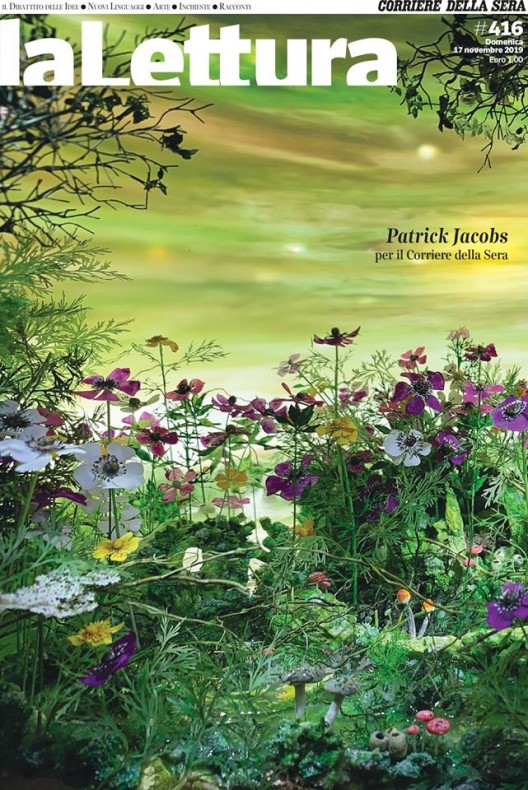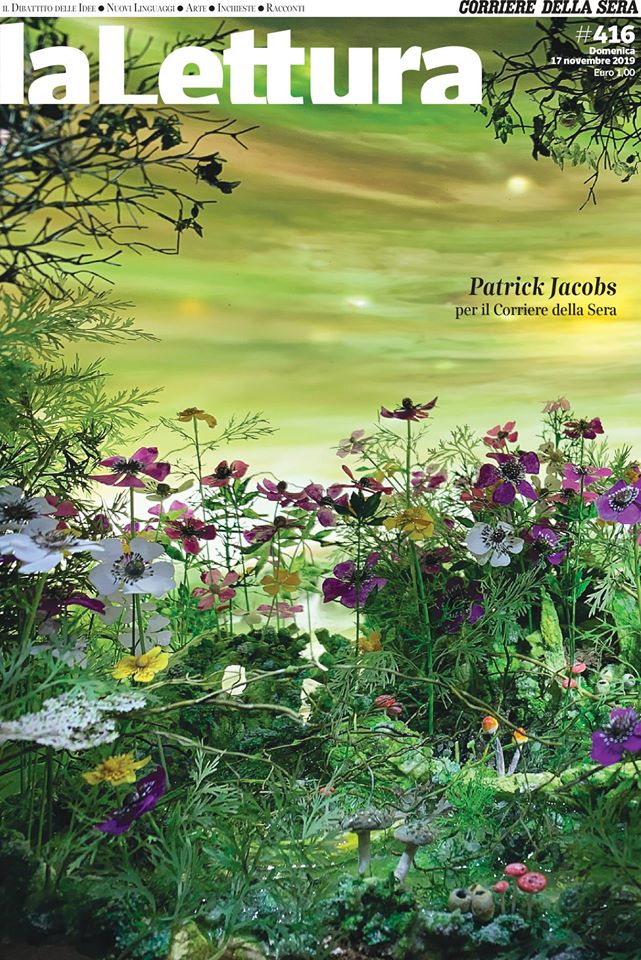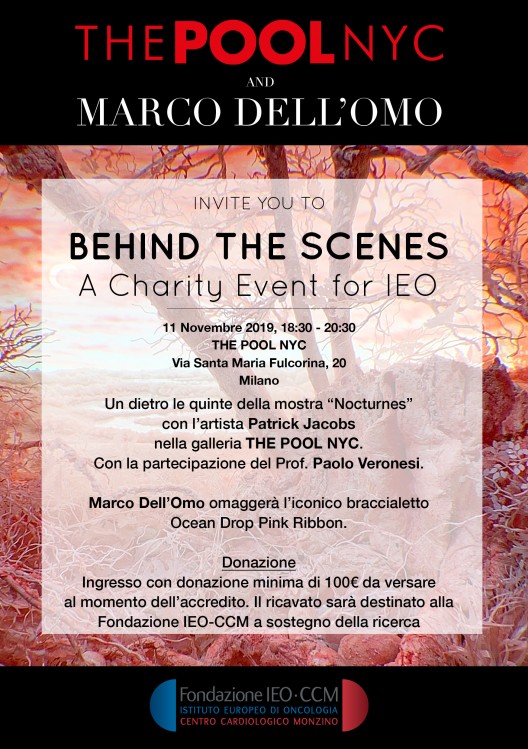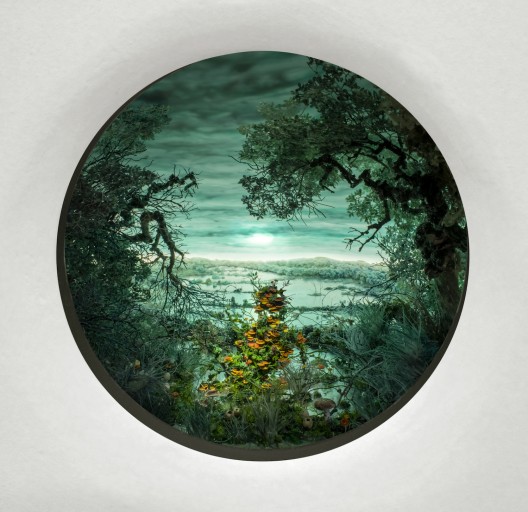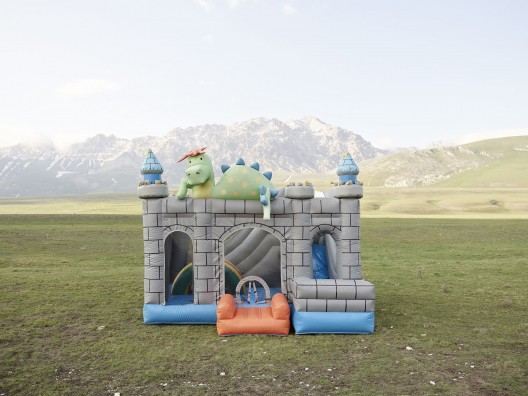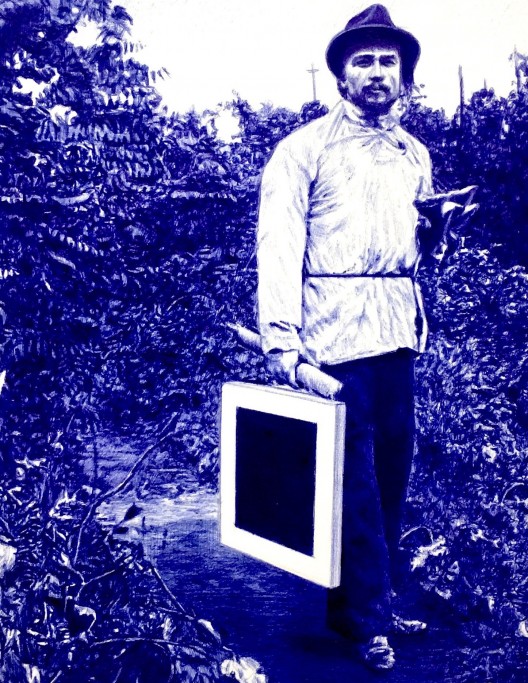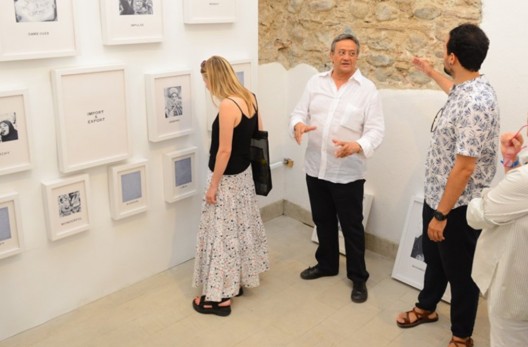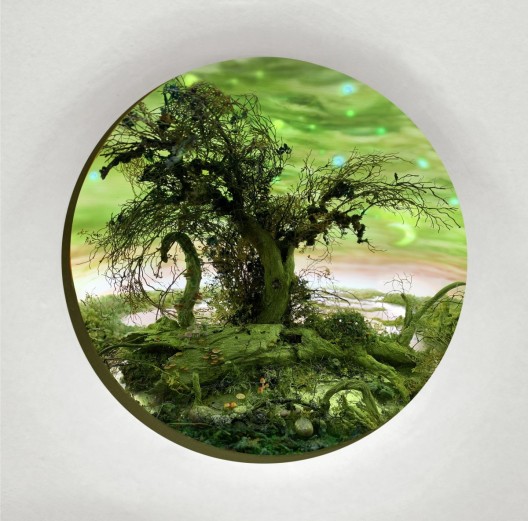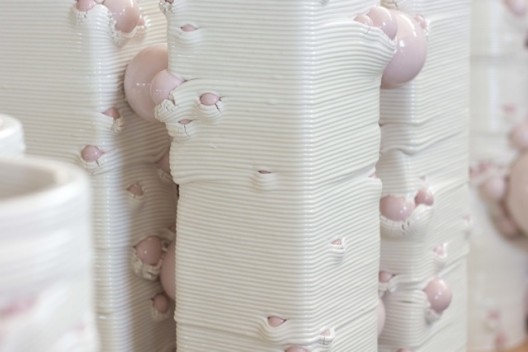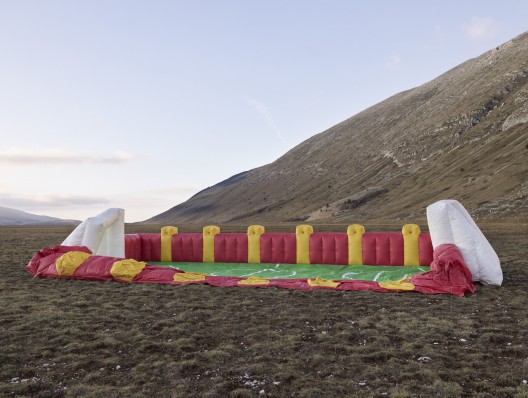Da CORRIERE DELLA SERA
La Lettura #416
Domenica 17 Novembre 2019
E’ il dettaglio di un campo fiorito, ma è solo la rappresentazione di un mondo irreale e incantato: Patrick Jacobs (Merced, California, 1971, ma vive a New York) è un artista che lavora sulla finzione e sul concetto di percezione.
L’opera della nostra copertina è il frutto di uno dei suoi diorami, ovvero ambienti in miniatura che l’artista realizza minuziosamente in ogni dettaglio e che solitamente rende visibili attraverso piccoli oblò collocati in una parete.
Patrick Jacobs per le sue opere impiega lenti convesse circolari che amplificano l’effetto di profondità, alterando la percezione visiva degli osservatori.
Il suo lavoro si snoda tra disegni, installazioni dal sapore surrealista e piccole sculture, ma soprattutto crea mondi artificiali, spesso legati alla natura, altre volte aderenti alla vita quotidiana ponendosi al confine tra ricostruzione scientifica e un nuovo immaginario estetico.
I suoi ultimi lavori (visibili alla Galleria The Pool NYC, a Milano) raccontano una natura sognata, talvolta con evocazioni erotiche, spazi come luoghi del desiderio. Jacobs assume il ruolo di creatore di mondi ideali e inviolabili, che si rivolgono soprattutto al nostro inconscio.
(Gianluigi Colin)
Lunedí 11 Novembre 2019 dalle 18.30 alle 20.30 ospiteremo un Behind the Scenes della mostra Nocturnes di Patrick Jacobs, che aprirà ufficialmente al pubblico il 14 Novembre.
THE POOL NYC vuole contribuire alla Ricerca per il Cancro con una serata speciale all’insegna della Beneficenza.
Gli ospiti, guidati dall’artista e dai galleristi, potranno cogliere tutte le fasi più salienti dietro alla realizzazione di una mostra d’arte contemporanea.
Sarà entusiasmante capire come funzionano i magici mondi creati da Patrick Jacobs cogliendone ispirazione, realizzazione e allestimento.
Nella prima sala sarà anche possibile scoprire una serie di lavori di altri artisti selezionati.
Per l’occasione il ricavato totale degli ingressi e una parte degli incassi della vendita delle opere d’arte della serata andranno in beneficenza all’Istituto Europeo Oncologico e Marco Dell’Omo regalerà a tutti i partecipanti l’iconico braccialetto Ocean Drop Pink Ribbon.
15 NOVEMBER 2019 – 14 MARCH 2020
THE POOL NYC is very proud to present Nocturnes, which showcases the work of the American artist Patrick Jacobs. We have followed Jacobs’ career with great enthusiasm over the past ten years, from our first studio visit with him in his apartment overlooking Prospect Park in Brooklyn, NYC (a source of inspiration for many of his micro worlds) to his monochromatic landscapes and large-scale installations of more recent years. We have now arrived at the Nocturnes. We are very excited to present his first solo exhibition in Italy.
Nature has always figured prominently in Jacobs’ work. In his earliest dioramas, he explored the ambiguous relationship humans have with the environment – a sense of wonder and astonishment, but also an underlying unease. His depictions of weeds and funguses, for example, reveal much about our cultural attitudes towards the natural world. His series of works of fairy rings draw on ancient legends in which spirits danced in circles causing mushrooms to spring up. Here, he conjures up the supernatural and, with it, a sense of fear and magic.
In Nocturnes, sensuality takes center stage as never before. Lush, fertile, and luxuriant flora allude to surreal and dreamy places. In the words of Shakespeare, Jacobs “uses the night as a cloak” through which he can enjoy the pleasures of a conspiratorial nature. And, like Dorian Gray, he escapes into the night to indulge his innermost desires, sometimes frightened by what he sees and simultaneously overwhelmed by irrepressible desires. We are faced with perturbing, poetic and seductive landscapes.
Opening Reception: November 14th 2019 from 6 to 8 pm.
Stefano Cerio – Constructions Instables
5-28 November 2019,
Istituto Italiano di Cultura, Paris
L’Aquila, dieci anni dopo il terribile terremoto del 2019. Michele Nastasi e Stefano Cerio, che si inscrivono tra i migliori fotografi italiani della loro generazione, ci conducono tra le rovine della città e nei suoi dintorni. Posano uno sguardo anticonformista su questo universo devastato, mostrandoci una realtà prigioniera delle impalcature o il sogno quasi infantile di una ricostruzione possibile. I loro clichés ci rivelano un mondo instabile, strano, sbalorditivo. Tra natura e cultura, decostruzione e costruzione, rigidezza e flessibilità, queste immagini forti e sorprendenti diventano il simbolo delle nostre contraddizioni e dei nostri sogni, spingendoci allo stesso tempo a interrogarci sul nostro futuro e a compiere un viaggio nel nostro immaginario.
I due fotografi saranno presenti al vernissage. Per introdurre le opere, abbiamo invitato Stefano Chiodi, professore di Storia Contemporanea all’Università di Roma Tre, e Jean-François Cabestan, architetto e storico dell’architettura.
L’esposizione sarà visitabile fino al 28 novembre (dal lunedì al venerdì, dalle 10 alle 13 e dalle 15 alle 18 e le sere in cui sono previsti altri eventi, come da calendario).
In collaborazione con il festival PhotoSaintGermain.
11 October-7 November 2019, Milano
THE POOL NYC presenta A PAINTING A DAY KEEPS THE DOCTOR AWAY/Un Quadro al Giorno leva il Medico di torno, una mostra collettiva con i lavori dei seguenti artisti: Gina Beavers, Mariella Bettineschi, James Case-Leal, Stefano Cerio, Eteri Chkadua, Maria Crispal, Aldo Mondino, Francesca Montinaro, Francesco Mori, Paolo Parisi, Sarah Revoltella, Andrew Sendor, Bianca Sforni, Giuseppe Stampone, Vedovamazzei.
L’arte, rimedio di molti mali, è vita ed è viva e con questa esposizione la vogliamo rendere ancora più animata e tangibile.
La mostra svela ogni giorno un quadro nuovo nella prima stanza di Palazzo Fagnani Ronzoni, sede della galleria. Si vuole dare all’opera esposta la massima importanza collocandola in uno spazio apposito, dove nessun altro lavoro distoglierà l’attenzione dalla stessa.
L’obiettivo è di creare un legame unico tra il lavoro esposto su una grande parete e il visitatore; l’opera isolata avrà un impatto più o meno forte sull’avventore. Si vuole capire cosa suscita in noi un’opera d’arte da sola.
L’indomani il lavoro passerà nella sala centrale della galleria, in attesa di essere raggiunto e “abbinato” dagli altri quadri selezionati per la mostra. Si avrà così la possibilità giorno dopo giorno, di vedere la differenza della fruizione di un quadro singolo, o di un gruppo di opere.
L’accostamento di un lavoro all’altro sarà una sorta di performance in corso ogni giorno e chi vorrà potrà assistere capendo il lavoro sia pratico (di appendere e collocare) che teorico che soggiace dietro all’allestimento di una mostra di arte. Il momento dell’accrochage sarà anche utilizzato per ragionare attorno al tema degli accostamenti artistici e con grande entusiasmo saremo felici di condividerlo quotidianamente con i nostri ospiti.
THE POOL NYC is proud to present A Painting a Day keeps the Doctor Away, a group exhibition featuring works by Gina Beavers, Mariella Bettineschi, James Case-Leal, Stefano Cerio, Eteri Chkadua, Maria Crispal, Aldo Mondino, Francesca Montinaro, Francesco Mori, Paolo Parisi, Sarah Revoltella, Andrew Sendor, Bianca Sforni, Giuseppe Stampone, and Vedovamazzei.
The art, remedy of many evils, is life and is alive and with this exhibition we want to make it even more animated and tangible. In the first room of Palazzo Fagnani Ronzoni, home of the gallery, the show reveals a new painting every day. We want to give the exhibited work the utmost importance by placing it in a special space, where no other work will draw attention away from it. The goal is to create a unique link between the work, displayed on a large wall, and the visitor; the isolated work will have a stronger impact on the art lover. The aim is to understand what a work of art can, if left alone, inspire in us. The next day the work will pass in the main room of the gallery, waiting to be reached and “matched” by the other paintings selected for the exhibition. In this way you will have the chance, day after day, to see the difference in the use of a single painting, or a group of works. The juxtaposition of one work to another will be a sort of performance in progress every day and the THE POOL NYC gives to the visitor the opportunity to follow the process that lies behind the preparation of an art exhibition: from the most practical aspects (to hang and place the work) to the theoretical ones (concept and related choices). The moment of the accrochage will also be used to reason about the theme of artistic combinations. We are delighted to share it daily with our guests.
REVOLUTION IS US – LA RIVOLUZIONE SIAMO NOI
21 July – 21 September 2019 / Autostrada Biennale in Prizren
Curated by Giacinto Di Pietrantonio
For AUTOSTRADA BIENNALE, Giuseppe Stampone presents “Primavera Araba” a unique piece consisting of 24 drawings inspired by the related files, taken from the internet at a time when they were censored for the West. The peculiarity of the piece is the artist’s choice to depict only women and children.
From Giacinto Di Pietrantonio.
It is only natural that by living in a world where virtuality has become crucial to our existence, the first thing we do when we have an idea is to find a reference, which means going on the internet and searching on Google for news or references to confirm our idea. If we search for “La rivoluzione siamo noi” on Google, we find 27.000.000 results in 0.47 seconds. A colossal number.
However, for anyone working with art, it is very encouraging to see that the first result which appears is Joseph Beuys’ piece of 1971, with the title “La Rivoluzione Siamo Noi”. The title has not been translated, because Beuys named the piece in Italian, as he thought and did the work in Italy. A large paper print, a kind of poster, produced by the Modern Art Agency in Naples. An inkjet print of 185 x 106 cm with 180 copies in which Beuys is shown walking towards us with his felt hat on his head, a white shirt with a fisherman’s vest, jeans, boots and a shoulder bag.
This is one of the contemporary works of art that I prefer both for formal reasons and those of its content. It’s the one thing I would take on a deserted island. So, it is a work which I keep with me for many years, ever since I learned of it. Then, a few years ago, I managed to get a copy of it, and I installed it at the entrance of my house. In fact, anyone who comes to visit me is welcomed not only by me, but also by Joseph Beuys who walks behind me towards the guest, and at that moment, Beuys, I and the guest or guests become “Revolution Is Us”.
It is clear that nowadays, even more so than a few decades ago, the word revolution sounds suspect, given the collapse of the great narratives promising revolution ever since the Enlightenment, be they on the right or left. Those that produced the well-known dramas of the 20th century, and because of which everyone by the end of the century was in such a rush to bury the word revolution. Unfortunately by doing so, they also buried the utopias and hopes for the future which the word represents.
However, what “La Rivoluzione Siamo Noi” makes me think of is not so much the political revolutions, but the personal ones, and in the case of art, the linguistic ones. Art is, even when it does not seem to appear that way, always a bearer of novelty, openness, change, and above all freedom. I never thought of art as merely aesthetic, or pure contemplative pleasure, but as a human expression full of ethics and aesthetics. But above all as an aesthetic at the service of ethics, as Walter Benjamin suggests, and to which in some way this work also owes something to the work ‘Wanderer above the Mist’ of 1818, by Caspar David Friedrich.
It is known that Benjamin talks to us about the “Angelus Novus” painting of 1920, by Paul Klee, which portrays the angel of history with its body turned towards the future while its face and gaze are turned towards the past, and therefore between the old and the new. While Friedrich in the 1818 ‘Wanderer above the Mist’ depicts a solitary figure of the man and romantic traveler artist looking out at a great expanse of fog with his back turned to us. It is the romantic solitude of man in the face of the greatness of nature that Beuys replicates in the photographic work “Difesa della Natura (clavicembalo)” in 99.5 x 67 cm. in 1981, exactly ten years after “La Rivoluzione Siamo Noi”.
We find here many of the urgent questions of contemporary society, ranging from the relationship with society, history, nature, our being in the world, not in a descriptive-didactic or passive way, but active and moving towards the future. Not in a didactic way, otherwise it would not be art, but in an active way, and when I say active I do not refer to an idea of activism, but to that change of consciousness that every work of art provokes more or less. In fact, it must be said that the work of Beuys has nothing “revolutionary” from the point of view of a didactic iconography that should have contained a political symbol. In this case, the German greens, or the like.
The work indicates the journey towards and in and for the world. As “La Rivoluzione Siamo Noi” suggests, we must move towards the future, because we are not angels being blown by the storm of paradise, and neither are we immobile and contemplative wayfarers of a sea of fog, the metaphor of an uncertain future. But, like art, we are beings in movement, walking towards the future, that, even if uncertain, we must always look for.
And it is this future we strive to understand with the new edition of Autostrada Biennale.
On the occasion of the 58th Venice Biennale, THE POOL NYC presents NOTTURNO PIÚ, a group show curated by Giacinto Di Pietrantonio.
There are the ones who see the nocturne in Giotto’s Comet, in San Pietro’s Liberation by Raffaello, in Tintoretto’s work, or even in the Two Men who contemplate the moon by David Caspar Friedrich. Others, in poetry like To the Moon by Giacomo Leopardi, in Whistler’s golden blue color, in the solar stars by Van Gogh, or in futuristic works by Balla and Boccioni. We could go back and forth from dawn to dusk in drawing up the list of artworks whose subject or setting is the night. Certainly, the night was very much courted by the romantics, an era in which the nocturne (nocturne en français) was born. First as a musical work, a form of free, sweet and moderate music that linked up with the serenade. Chopin wrote 21 Nocturnes, Beethoven cheers us with the Moonlight Sonata, even Satie and Debussy did not escape the enterprise. Even literature did not miss the night and the Nocturne as Theodor Amadeus Hoffmann or even Leopardi with the Night Song of a wandering shepherd from Asia. The invitation to the present Notturno Piùexhibit is borrowed from the first cover of the Notturno book, a collection of intimist pizzini written blindfolded because of wounds by the great poet Gabriele D’Annunzio. It is in this evocative frame that we inscribed information and artists’ names for the Notturno Piùexhibition. They are the ones whose work allows returning with the imagination and the memory in the night, in that space time border in which the imagination expands confidentially with the poetics of Mario Airò, Atelier Biagetti, Laura Baldassari, Bertozzi & Casoni, Michel Courtemanche, Mariella Bettineschi, Tomaso Binga, Stefano Cerio, CTRL ZAK, Eteri Chkadua, Jan Fabre, Patrick Jacobs, Ugo La Pietra, Lorenzo Marini, Maria Teresa Meloni, Alessandro Mendini, Aldo Mondino, Francesca Montinaro, Fabio Novembre, Maurizio Orrico, OVO, Paola Pivi, Sarah Revoltella, Jonathan Rider, Andrea Salvatori, Denis Santachiara, Federico Solmi, Giuseppe Stampone, Patrick Tuttofuoco, Vedovamazzei, Alice Visentin.
Ours is not only nocturne, it’s Notturno Più. As night and nocturne are also understood in the form of Blues and Jazz; not only because of the music of the soul, but because of the possibility of jam sessions that offer above all the second. Therefore, it’s an exhibition that is free and mildly moderate, intended as a musical score and set up in a scene writing mode as Carmelo Bene liked to say. A writing – an exhibition in which each artist enters himself and his different work as a composition of a collectively diversified vision with his own unique and complex poetics. The original ones by Mario Airò, the hospitable luxury by Atelier Biagetti, or portraits from the hidden physiognomy of Laura Baldassari‘s lysergic painting, Bertozzi & Casoni’s ceramic realism, the plastic skill of Michel Courtemanche, Mariella Bettineschi’s double feminine gaze, Tomaso Binga’s feminist alphabet, Stefano Cerio’s non-photographic places, the overturned project of CTRL ZAK, the painting testimony of the myths and everyday life of Georgia by Eteri Chkadua, the metamorphic melancholy now blue by Jan Fabre, the meticulous and silent Lilliputian dioramas of Patrick Jacobs, the critical architectural landscape reflections of Ugo La Pietra, the chromatically and futuristically mobile alphabets by Lorenzo Marini, the detailed and ancient portraits by Maria Teresa Meloni, the abstract-futurist signs-decorum by Alessandro Mendini, the illuminating ironic sculptures by Aldo Mondino, the potted plants that hide sculptures of migrant environments by Francesca Montinaro.Fabio Novembre’s tension towards the useless, the abstract-informal paintings by Maurizio Orrico, the precariously hardcover project by OVO, the expansive sign energy of Paola Pivi, the sculptural portraits of the polarized families by Sarah Revoltella, the discrete and almost invisible environmental sculptures by Jonathan Rider, the cosmic vases by Andrea Salvatori, the animated-figured project by Denis Santachiara, the exuberant, noisy and ironic works of Federico Solmi, the responsibly ethical drawings by Giuseppe Stampone, the re-reading of the daily visual codes in the light of the multidisciplinary nature of Patrick Tuttofuoco, the ironic and arrogant landscapes by Vedovamazzei, the playfully shamanic paintings by Alice Visentin.
With this diversity made of 31 artists, the exhibition is an expressive chorus of poetics, techniques, materials that form Notturno Più, where the Più (Plus)is no longer just for the night, but the day and night together, like our life, they can no longer be solitary. This is a group show, an exhibition practice in which you need to be at least in two, the one and the other. Starting a community that counts 31 others, 31 artists with countless works to us, as to them, necessary both day and night to be found in the Notturno Più.
WHERE:
THE POOL NYC at PALAZZO CESARI MARCHESI
Campo Santa Maria del Giglio
Calle Rombiasio 2539 Venezia. Vaporetto Stop: GIGLIO
WHEN:
Opening Reception: Tuesday, May 7th, from 6 to 9 pm
8 May-15 June 2019
Open daily: 11-7
INFO:
+393356251723
+393337891947
thepoolnewyorkcity.com
@thepoolnyc
THE POOL NYC, Palazzo Cesari Marchesi, Calle Rombiasio 2539, Campo Santa Maria del Giglio, Venezia
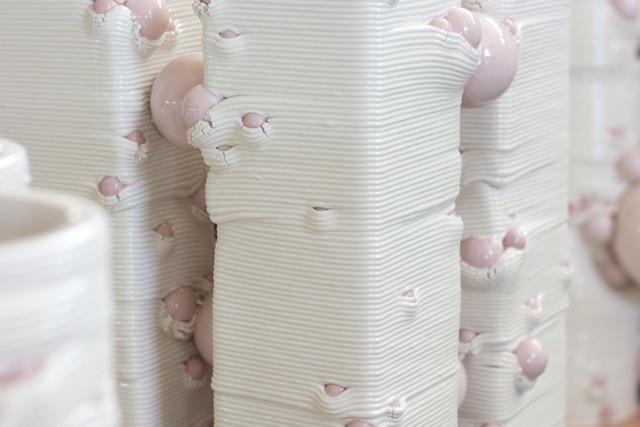
3 April – 31 May 2019
Opening Reception: Tuesday, April 2nd, from 6 to 9 pm
THE POOL NYC presenta Ikebana Rock’n’Roll, la personale del Maestro della Ceramica Contemporanea, Andrea Salvatori, in conversazione con Giulio Turcato, uno dei principali esponenti dell’Astrattismo Informale Italiano.
THE POOL NYCpresenta Ikebana Rock’n’Roll, la personale del Maestro della Ceramica Contemporanea, Andrea Salvatori, in conversazione con Giulio Turcato, uno dei principali esponenti dell’Astrattismo Informale Italiano.
Salvatori plasma da sempre la ceramica, materiale inorganico, assai duttile allo stato naturale e rigido dopo la cottura. Se nel 2009, agli esordi con la galleria, l’artista proponeva lavori in cui associava inserzioni in ceramica a pezzi trovati in mercatini d’antiquariato, adesso, per la prima mostra nella sede milanese, esordisce con una serie di vasi spumosi, carichi di materia, formosi, pieni di ritmo e poesia.
Per Ikebana Rock’n’RollAndrea Salvatori presenta una serie di vasi bianchi con sfere di diversi toni di rosa, inserite come note musicali,a volte più ritmate, altre più calme. Questi lavori sono pensati come Ikebana, dove natura e spirito si fondono nel tentativo di associare la spiritualità orientale con una leggerezza minimale. L’Ikebana utilizza fiori, rami ed altri elementi naturali per realizzare composizioni di grande bellezza.
“La ricerca dell’equilibrio tra tutti gli elementi passa anche dal contenitore. Ci sono numerose scuole di Ikebana e ognuna opta per un arrangiamento particolare. Alcune usano vasi alti e linee verticali, altre invece contenitori poco profondi”. Infatti i lavori dell’artista faentino hanno dimensioni e forme diverse e il vaso abbraccia così il concetto di scultura con una funzione ben precisa.
Per ladisposizione pratica dei fiori si punta all’asimmetria, tratto caratteristico del lavoro di Salvatori, il quale crea con la ceramica un’armonia speciale,Allegro, Grave, Vivace, Moderato,proprio come nelle composizioni musicali. Alcuni lavori sono più tormentati, più pieni, rock, altri più poetici, più vuoti.
Quello tra Andrea Salvatori e la stampa 3D è un confronto inedito, esuberante e al contempo composto, fatto di fugaci imperfezioni e di pause ragionate, che origina da un’innata conflittualità tra creazione umana e artificio tecnico, tra uomo e macchina. La macchina, in questo caso, è la stampante Delta WASP 40100 Clay, progettata da WASP per essere al fianco dei ceramisti durante tutto il processo artistico, ripensando radicalmente l’ideazione dell’opera grazie alle innovative opportunità offerte dalla fabbricazione digitale.
La stampa 3D è il simbolo di una nuova corrente artistica, frutto di repertori digitali unici e tuttora non sondati dall’arte contemporanea. La collaborazione tra WASP e il Maestro si prefigge di delineare inediti scenari artistici, in cui routine meccaniche e gestualità scultoree coesistono nel dialogo compositivo dell’opera. Salvatori concepisce questo rapporto con un’intuizione estremamente affascinante: manomettere la perfezione della stampa con una miscellanea di inserzioni ceramiche. Il processo di deposizione del materiale e di incastonatura delle sfere è tema centrale nella collezione Ikebana Rock’n’Roll, al punto da convincere Salvatori a denominare le opere “Composizione 40100”, come scaturite da un dialogo musicale dalle tonalità più svariate.
L’artista sconvolge l’algoritmo reiterato pedissequamente dalla macchina con accenti musicali imperfetti, frutto di volta in volta di azioni spontanee e processi ragionati.
Sorge naturale associare le sculture di Salvatori ai dipinti di Turcato: due sperimentatori in fatto di materia.
Giulio Turcato, una presenza costante a La Biennale di Venezia, ha indagato per tutta la vita la materia, usando fluorescenze, pastiglie, sabbie, acrilico e olio.
Nel 1947 Turcato è tra i firmatari di FORMA 1, dove esprime un interesse per una pittura formalista. Nel 1956, dopo un viaggio in Cina, forti sono i riferimenti agli ideogrammi, da cui la nascita dei cosiddetti Reticoli, un trionfo di forme attraverso il colore, che assume una valenza astratta in relazione proprio con se stesso. Col passare degli anni l’artista tende all’assenza della forma.
Agli inizi degli anni ’60 Giulio Turcato viene colpito dalle nevrosi contemporanee e inserisce nei suoi lavori i Tranquillanti, giocando con la materia pittorica e dando vita a composizioni brillanti, astratte, tutte con un piglio musicale. Negli anni delle conquiste spaziali il Maestro inventa opere con sabbie colorate cangianti affermando “la mia ricerca coloristica è orientata verso un nuovo colore…”. È del 1964 la prima Superficie Lunare, realizzata con una striscia di gommapiuma lavorata e combusta. Sarebbe soddisfatto di vedere oggi i toni che hanno assunto i colori da lui medesimo creati.
Nei lavori dell’artista nato a Mantova e mancato a Roma c’è un acceso ritmo informale generato dalla diversità dei materiali usati nelle fasi della sua produzione. THE POOL NYC propone una selezione di opere che spazia dai Reticoli, alle Superfici Lunari, ai Tranquillanti,fino agli Arcipelaghi.
Ikebana e Rock’n’Roll sono in totale contrasto: il primo legato alla spiritualità, il secondo al ritmo di vita terreno e festaiolo. Tutto quanto esiste in natura può essere trasformato in materiale compositivo, purché interpretato nella sua essenza di elemento naturale, riordinato e riespresso e, da inerte, reso vivente. All’origine è dunque la natura, fonte inesauribile di materia prima, modello perfetto che l’uomo può imitare e che l’artista non deve contraffare. Non dimentichiamo che la natura non ripete mai identica una stessa forma, pur moltiplicandola in una quantità potenzialmente infinita.
THE POOL NYC presents Ikebana Rock’n’Roll, the solo show by the Master of Contemporary Ceramics, Andrea Salvatori, in conversation with Giulio Turcato, one of the main exponents of Italian Informal Abstractism.
Salvatori has always molded ceramics, an inorganic material that is very ductile in its natural state and rigid after cooking. Since his debut with the gallery in 2009, where the artist proposed works in which he associated ceramic inserts to pieces found in antique markets, till this first exhibition in the Milanese Gallery, he shows a series of foamy vases, full of matter, curvy, loaded with rhythm and poetry.
For Ikebana Rock’n’RollAndrea Salvatori presents a series of white vases with spheres of different shades of pink, inserted as musical notes, sometimes more rhythmic, sometimes more calm. These works are conceived as Ikebana, where nature and spirit merge in an attempt to associate Oriental spirituality with minimal lightness. Ikebana uses flowers, branches and other natural elements to create compositions of great beauty.
“The search for balance between all the elements also passes through the container. There are numerous schools of Ikebana and each one opts for a particular arrangement. Some use tall vases and vertical lines, others use shallow containers.” In fact the works of the artist from Faenza have different dimensions and shapes and the vase thus embraces the concept of sculpture with a very specific function.
For the practical arrangement of the flowers, the aim is asymmetry, a characteristic trait of Salvatori’s work, which creates a special harmony with ceramics: Allegro, Grave, Vivace, Moderato, just like in musical compositions. Some works are more tormented, fuller, rock, others more poetic, empty.
The one between Andrea Salvatori and 3D printing is a new and exuberant confrontation, made of fleeting imperfections and reasoned pauses, which originates from an innate conflict between human creation and technical artifice, between man and machine. The machine, in this case, is the Delta WASP 40100 Clay printer, designed by WASP to be at the side of the ceramists throughout the artistic process, radically rethinking the conception of the work thanks to the innovative opportunities offered by digital fabrication.
3D printing is the symbol of a new artistic current, the result of unique digital repertoires and still not probed by contemporary art. The collaboration between WASP and the Maestro aims to outline new artistic scenarios, in which mechanical routines and sculptural gestures coexist in the compositional dialogue of the work. Salvatori conceives this relationship with an extremely fascinating intuition: to tamper with the perfection of printing with a miscellany of ceramic insertions. The process of depositing the material and setting the spheres is a central theme in the Ikebana Rock’n’Roll collection, to the point of convincing Salvatori to name the works “Composition 40100”, as if they originated from a musical dialogue of the most varied tones.
The artist alters the repeated algorithm with imperfect musical accents, as a result of spontaneous actions and reasoned processes.The first Lunar Surface dates to 1964 with a strip of processed and burnt foam rubber. He would be pleased to see today that tones have taken on the colors he created himself.
Stefano Cerio, Aquila.
Con Saluti dall’Abruzzo di
Giuseppe Stampone
SABATO 23 MARZO DALLE 17 in galleria
Mercoledi 20 Febbraio ore 19
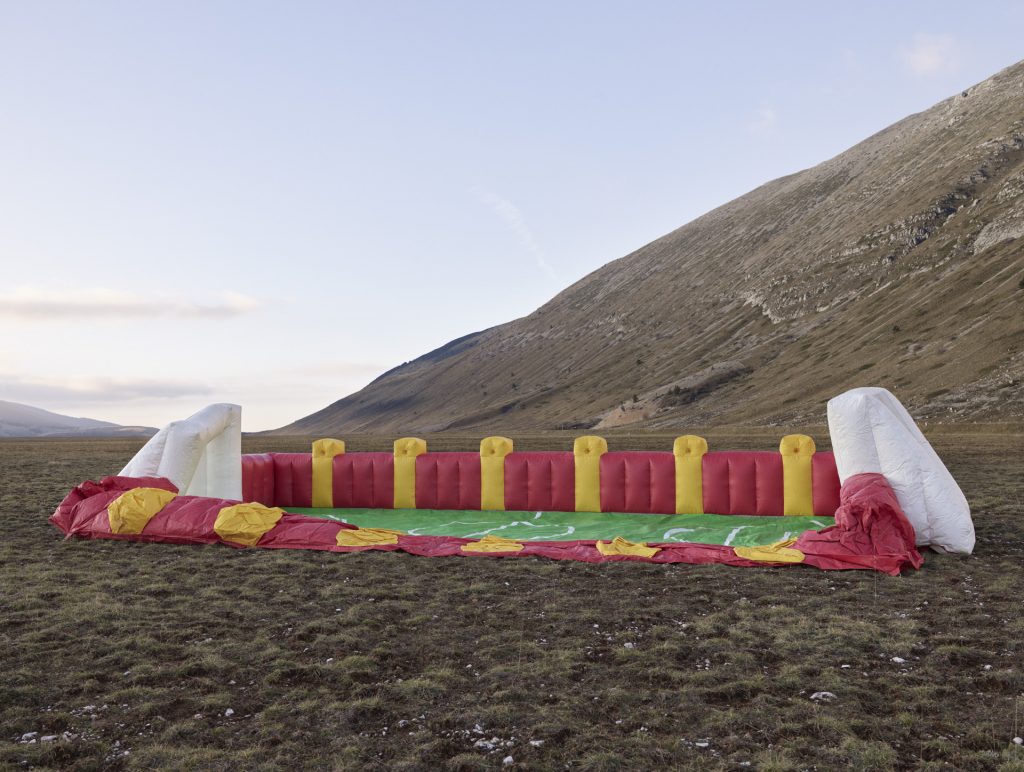
Artist Talk: STEFANO CERIO in conversazione con ANGELA MADESANI
STEFANO CERIO, Aquila
Con Saluti dall’Abruzzo di Giuseppe Stampone
| Dal 24 gennaio al 23 marzo THE POOL NYC presenta Aquila, la mostra personale di Stefano Cerio con il contributo dell’artistia abruzzese Giuseppe Stampone. L’esposizione vuole essere un omaggio all’Abruzzo e alle zone colpite dal terremoto del 2009. Il progetto di Stefano Cerio è incentrato sull’installazione di una casa gonfiabile nel poetico tentativo di dar vita a una ricostruzione fittizia. Nei precedenti lavori l’artista si è già occupato del gioco, ritraendo alcuni luoghi dedicati al divertimento: Aqua park, navi da crociera, luna park. Questi luoghi, fotografati nel momento in cui nessuno li abita, sono ritratti di assenze. Sono le persone, o meglio la loro mancanza, a rendere questi luoghi ancor più surreali. Ma nei lavori della serie Aquila c’è un’evoluzione: non è più il posto ad essere surreale, ma l’effetto finale dato dal collocare dei gonfiabili dalla forte connotazione ludica, in un luogo dove non dovrebbero esserci. Siamo di fronte a un lavoro installativo, dove la fotografia serve a documentarne un processo, non a crearlo. Il luogo naturale assume un significato diverso con l’aggiunta del gonfiabile, che diventa quasi un oggetto metafisico. Collocare una casa gonfiabile, che per sua natura è antisismica, è un atto di fede: infatti buona parte della regione colpita dal dramma non è stata ancora del tutto ricostruita e in questo modo si ambisce, almeno idealmente, a riedificarla. Nella mostra sono presenti anche i lavori di un artista abruzzese a cui è molto caro il tema: Giuseppe Stampone. L’artista ha voluto omaggiare la propria regione con alcune rilevanti opere che completano il progetto ideato da Cerio. Stefano Cerio vive e lavora tra Roma e Parigi. Selected Solo Exhibitions |

